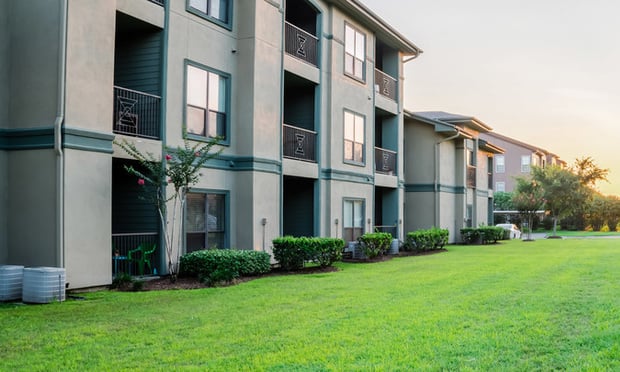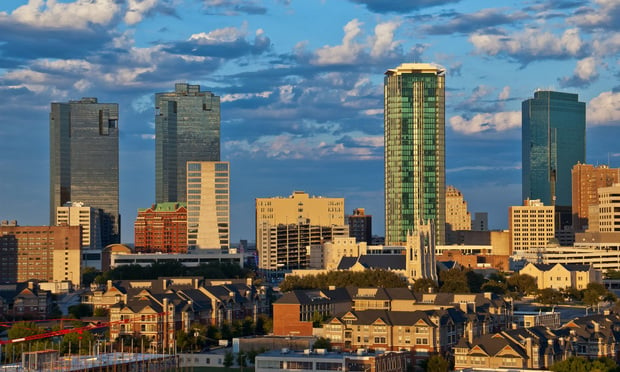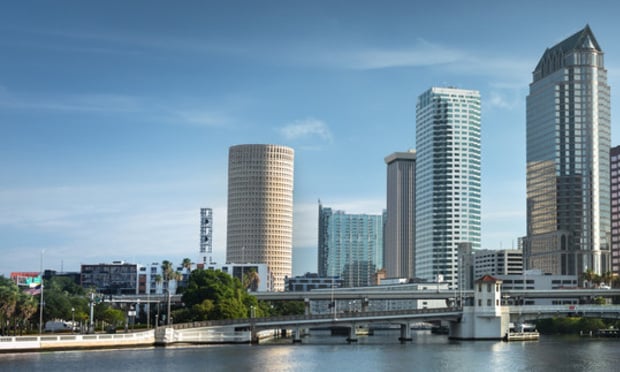Kaplan Acquisitions LLC of Houston is completing site work on a 13-acre tract to develop the 350-unit District @ Greenville Apartments at 11911 Greenville Ave. To the south, Dallas-based Prescott Realty Group is readying its 3.5-acre tract at the corner of Greenville and Yale Boulevard, where it will build a trio of connected five-story buildings with 412 units on four upper floors and 18,000 sf of street-level retail. Mark Humphreys of Dallas-based Humphreys & Partners Architects LP tells GlobeSt.com that the proprietary e-Urban design will result in Kaplan's project being 86% more efficient than a traditional multifamily development would have been on the infill site while Prescott's mixed-use will be about 85%.
Kaplan's District @ Greenville will have five residential buildings and one clubhouse, all surface parking. The mix is 45% one-bedroom units and the balance as two bedrooms, with 1,000 sf as the average of the floor plans. Delivery is planned for fall 2009.
[IMGCAP(2)]Prescott's project, which has yet to be named, is an e-Urban podium design, one of 10 copyrighted variations that the Humphreys' team has worked up since mid-2007 when the specialty line-up hit the market. Fifty-one percent of Prescott's units will be one-bedrooms and the balance is two bedrooms, with their average coming in at 776 sf. The podium design has a 507-space parking garage for residents, visitors and shoppers. The project's completion is eyed for spring 2010.
Since the father of the "Big House" design rolled out the e-Urban to the marketplace, roughly 50 projects have been started in the US, according to Humphreys, who is awaiting delivery of the first born. The high-efficiency building design replaces long corridors with shorter ones and places elevators or interior steps at all four corners for access to all levels.
[IMGCAP(3)]The Humphreys team has added an e-Urban student-housing design, one of which is underway near Baylor University in Waco, TX and another is in the planning stages near Texas Tech in Lubbock. Humphreys confides that a seniors' housing version is on the drawing board in the firm's Las Vegas office and a hotel version is working through the R&D pipeline in Dallas.
"The original version has morphed. It's been adapted to different needs and different locations," Humphreys explains. "I'm not sure that since our Big House design [$5 billion of developments since 2003] have we had as much interest in a proprietary design as the e-Urban."
Humphreys says the "green" factor is wrapped into the space efficiency ratio because it requires less building materials and has a higher impact on non-revenue producing items. The e-Urban efficiency ratio ranges from 85% to 87% while traditional development is 65%. "That's why we are getting so many calls and have so many projects going on. It's cheaper to build," he says. "We recognized construction costs had way outpaced rental increases on high-density wood-frame projects."
Want to continue reading?
Become a Free ALM Digital Reader.
Once you are an ALM Digital Member, you’ll receive:
- Breaking commercial real estate news and analysis, on-site and via our newsletters and custom alerts
- Educational webcasts, white papers, and ebooks from industry thought leaders
- Critical coverage of the property casualty insurance and financial advisory markets on our other ALM sites, PropertyCasualty360 and ThinkAdvisor
Already have an account? Sign In Now
*May exclude premium content© 2024 ALM Global, LLC, All Rights Reserved. Request academic re-use from www.copyright.com. All other uses, submit a request to [email protected]. For more information visit Asset & Logo Licensing.








